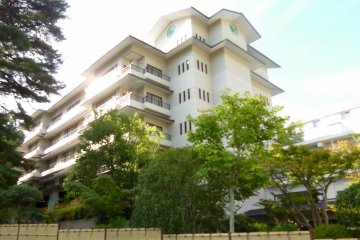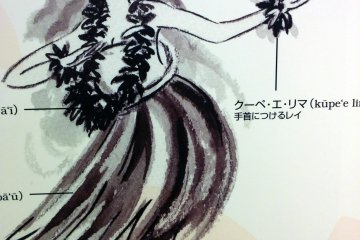Known as Japan’s third largest prefecture, Fukushima is located in northeastern Japan’s Tohoku region and shares an eastern border with the Pacific Ocean. The expansive prefecture has no shortage of natural beauty, historical and cultural sites, hot springs, quality sake, and fresh seafood. Despite the severe impact of the Great East Japan Earthquake and following tsunami in 2011, Fukushima has rebounded tremendously, demonstrating the resilience of its people.
If you follow Japan’s Pacific coastline northward from Tokyo, the first city you will meet in Fukushima is Iwaki City. This seaside city has a dynamic history—evolving from a coal mining powerhouse to a destination famous for its Hawaiian-themed resort.. The city even has its own Iwaki-discovered dinosaur fossil, and from its coastal observatories, you can enjoy unobstructed views of the ocean. The city is full of surprises! However, you probably could have guessed that Iwaki’s presence in the fishing industry is strong.
In this article, we are going to shine a spotlight on Iwaki-located company Yuzuki, one of the top producers of kamaboko in Japan!
What is kamaboko?

Kamaboko is a type of traditional Japanese fish cake, and its ingredients generally include surimi, which is white fish pounded into a paste, salt, sugar, egg whites, fish sauce, and sake. These ingredients are then molded into a loaf shape and steamed, baked, fried, or poached. In its most basic form, kamaboko has a mild fishy taste and a satisfying texture that is both chewy and smooth.

Kamaboko most often makes its appearance in osechi-ryori, which are traditional Japanese New Year dishes. Each dish symbolizes a certain sentiment for the new year, and alternating red and white kamaboko represent good luck, as these colors are associated with the same.
Of course, kamaboko is also enjoyed year-round. You can find it as a garnish for ramen or udon, a boost of protein in bento boxes, a drinking snack, or an addition to fried rice. Itawasa is the most common way Japanese people enjoy it, which is when kamaboko is sliced, served with wasabi, and dipped in soy sauce, resulting in a umami-filled bite of fish, salt, and spice.
Yuzuki: Over 70 years of kamaboko production

Yuzuki’s story began in 1951 under the name Maruyasu Fisheries. However, just 12 years later in 1963, the company changed its name to Yuzuki and shifted its focus to kamaboko production—capitalizing on its prime oceanside position and wealth of fresh local fish. In the 1970s, Yuzuki reinvigorated its manufacturing process with machinery and automation and started gaining recognition in eastern Japan thanks to its TV commercials featuring well-known actresses and sumo wrestlers.

As the company’s output increased significantly, its commitment to quality and hygiene never wavered, and it developed a production method to eliminate any risk of contamination by sealing its products prior to steaming. By the 1980s, Yuzuki became a household name in Japan, and its products became commonplace in grocery stores.
Today, Yuzuki is one of the top producers of kamaboko in Japan—producing 70,000 to 80,000 kamaboko a day, and 100,000 daily during high-demand seasons.

Yuzuki’s kamaboko is free from preservatives and synthetic coloring and does not contain wheat, egg whites, or milk, allowing people with these common allergies to enjoy its products too! Yuzuki does not stop at standard kamaboko either and is creatively branching out, offering exclusive kamaboko varieties that mix unexpected flavors.
Interested in Yuzuki’s kamaboko? Visit Yuyu-an!

If you are in Iwaki City, treat yourself with a visit to Yuzuki’s very own shop, Yuyu-an, situated directly next to its manufacturing plant. Here, you can purchase special kamaboko products that are not sold anywhere else! Since kamaboko doubles as both an excellent source of protein and an integral part of Japanese cuisine, it is the perfect food to nourish your body and satiate your desire for cultural exploration.
Quick product shoutouts!
We recommend Yuzuki’s basic kamaboko, chikuwa, sake kasu kamaboko, and Hama dog. Read on to learn more about these delicious eats.
Yuyu-an is a one-stop-shop for all your kamaboko needs, whether you are looking for a quick snack on the go, a collection of delicious eats for a kamaboko-inspired picnic, or a late night snack spread at your accommodation.

Aside from Yuzuki’s general kamaboko, which is a must-buy of course, Yuyu-an also sells seasonally-shaped kamaboko, chikuwa, which is a type of fish cake wrapped around a bamboo stick that Yuzuki grills by hand (only available at Yuyu-an), sake kasu kamaboko, and its newly launched Hama dog.
The sake kasu kamaboko is an original Yuzuki recipe that combines surimi, salt, sugar, starch, miso, mirin (sweet rice wine), and sake kasu, which is a byproduct of sake-making. The sake kasu lends the kamaboko a dryness that is reminiscent of some sake products and dampens the fishy flavor.


For a savory, rich, and western-inspired version of kamaboko, Yuyu-an’s Hama dog is the product for you. This unique play on a hotdog has a cheese and bacon-flavored kamaboko base encircled by bread. The product is then deep fried, resulting in a decadent bite that has contrasting textures of crunchiness and smooth chewiness. We recommend purchasing a variety of Yuyu-an’s products so you can compare all of its flavors—from traditional to modern fusions.
Sake is often a favored counterpart to kamaboko, and luckily, Fukushima is renowned for this beverage. So, while at Yuyu-an, we also recommend that you pick up a bottle of sake—all of which are produced in Fukushima—to elevate your kamaboko experience.
Yuyu-an is open from 9:30am–5pm and closed every Wednesday.
Kamaboko-making workshops
If simply eating kamaboko doesn’t satisfy your curiosity, Yuzuki also offers two kamaboko-making workshops, “Kamaboko Art” and “Chikuwa-making.”

The Kamaboko Art workshop is the perfect outlet to let your inner artist shine. Here, you can shape and decorate your own kamaboko with a colorful selection of natural food coloring. The kamaboko are then steamed and sent home with the creator.

For the Chikuwa-making workshop, you can create your own chikuwa by forming the raw materials around a bamboo stick. Yuzuki then grills the chikuwa and provides you with your uniquely shaped product at the end.
Although both courses are conducted in Japanese, you can easily understand the steps through the instructors’ gestures.
Workshop details:
- Workshop URL: https://www.kk-yuzuki.co.jp/factory/
- Reservations via phone (0246-75-1666) are required 10 days in advance
- Workshop fee: 500 yen
- Kamaboko Art has one session per day from 10:30am–11:30pm (60 minutes)
- Chikuwa-making has two sessions per day from 10:30am–11:00am and 1:30pm–2:00pm (30 minutes)
- The workshops are closed on Wednesdays, Sundays, public holidays, and from November to January (Yuzuki’s busy season)
Sightseeing in Iwaki
In addition to its famous kamaboko, Iwaki City is also home to numerous attractions that showcase its legacy and charms. Pair your gastronomic journey with these popular spots.
Iwaki City Coal and Fossil Museum

Iwaki City Coal and Fossil Museum, as the name suggests, showcases a unique combination of Iwaki’s coal mining history and fossils from around the world. Upon entering, you will first meet the fossilized remains of Futabasaurus, Iwaki’s resident dinosaur. This type of plesiosaurus was discovered in Iwaki in 1968 and lived about 85 million years ago.

The main fossil hall exhibits an impressive collection of dinosaurs including recognizable icons like Tyrannosaurus Rex and Triceratops. However, the fossil of Mamenchisaurus is one of the museum’s most renowned displays as it is the largest complete dinosaur fossil found in Asia. Every 15 minutes, the fossil room has a projection show with color and sound, taking you on a journey through land, sky, and sea, so be sure to check it out.

After traveling to the far past, board an elevator that simulates plunging you 600 meters into the Earth and step into the lives of coal miners from the mid-1800s to around the 1970s. The reproduced tunnels feature scenes that illustrate the evolution of coal mining. The dim lighting, realistic displays with mannequins, and mining artifacts truly capture the atmosphere of the corresponding times.
Although the museum descriptions are in Japanese, you can ask the front desk for an English pamphlet that provides information about the exhibits.
Misaki Park and Iwaki Marine Tower

Misaki Park is an expansive green oasis that juts out into the Pacific Ocean. The lush retreat has green lawns for picnicking (perhaps with kamaboko), playground equipment, a hedge maze, observatories, and more. The park’s most iconic landmark is Iwaki Marine Tower, which is popular for its observation deck at 106 meters above sea level and rooftop sky deck. From both decks, you can enjoy elevated views of the park’s greenery, the adjacent harbor, Iwaki’s cityscape, distant hillsides, and of course, the endless sea.


For a more intimate seaside experience, you can also visit Shiomidai Observatory, which has a path that extends over the ocean. Here, the aroma of the sea breeze is stronger and you can watch the melodic ebb and flow of the waves as they interact with the rocky shoreline.
Spa Resort Hawaiians

After Iwaki’s coal mining operations ended with the advent of new energy sources, the city rebranded itself as a Hawaiian-themed getaway and opened Spa Resort Hawaiians. This massive complex has four accommodation facilities and six theme parks where guests can enjoy thrilling water rides, as well as relaxing hot springs sourced from Iwaki Yumoto Hot Spring, one of Japan’s three oldest hot springs.

The facility exudes tropical vacation vibes—from its restaurants to its activities to its shops—and even provides you with your own flower-imprinted garment to fashionably immerse yourself in the environment.
One of Spa Resort Hawaiians’ most famous attractions is its Polynesian hula and fire dancing show. All of its talented hula dancers have completed intensive training at Joban Music and Dance Institute. The heart-pounding fire dancing coupled with the sometimes graceful, sometimes lively hula performances create an all around captivating show supported by live music. You cannot help be entranced by the ever-changing energy of the performers.



Explore Iwaki City, Fukushima
Iwaki Station is easily accessible from Tokyo Station via the Hitachi and Tokiwa limited express trains. The roughly two hour and 20-minute train ride takes you on a scenic trip through quaint farmland and offers glimpses of the Pacific Ocean as the train orients itself along the coastline.
From its eclectic history to its ocean vistas and renowned kamaboko, Iwaki is a local favorite among Fukushima’s vast offerings. While you are in the area, be sure to stop by Yuzuki and treat yourself to some of Japan’s most cherished kamaboko.
Looking for more Tohoku seafood?
Yuzuki’s kamaboko is just one example of the Tohoku region’s rich seafood legacy.Visit our Seafood Journey feature page to dive into northeastern Japan's culinary delicacies and discover more passionate seafood and marine product processors.





























